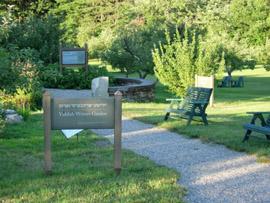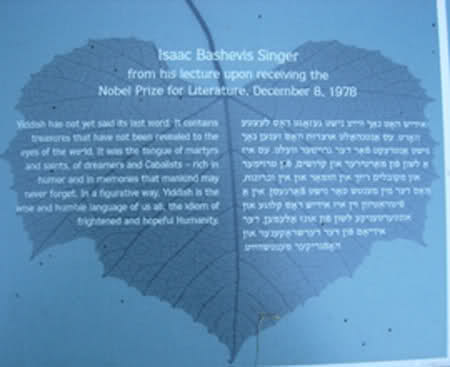269. Travel part 2: Poetry to Photography: The National Yiddish Book Center

The National Yiddish Book Center is located on the Hampshire College Campus in Amherst, Massachusetts
click here for Part 1 of trip.
Photo from 2007 trip along with first slide show and poetry.
Before I proceed, I would like to offer a little information on the Yiddish language. The most basic description would be a mix of Hebrew and medieval German with a smattering of other languages. It was spoken by the Jews of central and eastern Europe.
The photos show the outside of The National Yiddish Book center, which houses over a million Yiddish books that were rescued from extinction. It also is a cultural center where Jews from all over the world come to experience their culture.
The outside is lovely; a path leads one to a contemplative retreat. A pond with falling water and beautiful plants pays homage to the many Yiddish writers who have been and who still are. Plaques with a poem or piece of their work line the path. As one stops to read with the sound of flowing water and birds singing nearby, one cannot help but feel moved.
Isaac Bashevis Singer
from his lecture upon receiving the Nobel Prize for Literature
December 8, 1978
Yiddish has not yet said its last word. It contains treasures that have not been revealed to the eyes of the world. It was the tongue of martyrs and saints, dreamers and Cabalists–rich in humor and in memories that mankind may never forget. In a figurative way, Yiddish is the wise and humble language of us all, the idiom of frightened and hopeful humanity.
God of Mercy
Kadia Molodowsky
O God of Mercy
Choose-
Another people.
We are tired of death, tired of corpses.
we have no more prayers.
Choose-
Another people.
We have run out of blood
For victims.
Our houses have been turned into desert.
The earth lacks space for tombstones,
There are no more lamentations
Nor songs of woe
In the ancient texts.
~Translated by Irving Howe
2008: New exhibits, new photos
This year’s visit to the National Yiddish Book Center, where there are thousands of Yiddish books being saved, cataloged and scanned, featured the haunting photographs of Roman Vishniac.
Children of a Vanished World: Photographs by Roman Vishniac
A traveling exhibition curated by the Museum of Jewish Heritage—A Living Memorial to the Holocaust
Between 1935 and 1938, Roman Vishniac, perhaps the most well-known photographer of pre-War European Jewry, took thousands of photographs of shtetls and cities in Eastern Europe and the Jews who called them home. Fifty of these pictures were first shown in New York City in 2000 in this captivating presentation which will be on view at the National Yiddish Book Center from May 4 – August 31, 2008.
These haunting images were taken when Vishniac was on assignment for the American Jewish Joint Distribution Committee in Eastern Europe to photograph poor Jews to be featured in a fund-raising effort. He was particularly drawn to the ubiquitous images of traditional Jewish life. Sometimes using a hidden camera, Vishniac was able to capture the real moments in the lives of his subjects. Children, a favorite topic of Vishniac’s, were photographed in the course of everyday routine, just before their world was about to change forever. A musical “sound loop,” containing six Yiddish songs, was created especially for this exhibition to complement and give context to the photographs.
As the Jews of Germany encountered worsening conditions under Nazi rule, Vishniac made plans to safeguard his photographs. Through the efforts of family and friends, nearly 2,000 negatives reached the United States. In May 1939, his daughter, Mara, was sent to Sweden where her mother and brother later joined her. During that time, Vishniac was in France and eventually was detained in an internment camp for several months. The family was reunited in Lisbon and came to the United States in 1940.
Vishniac’s photographs were published in the book Children of a Vanished World (University of California Press, 1999). The book features translations of Yiddish nursery rhymes, songs, poems, and chants for children’s games accompanying the photographs. The volume was co-edited by the photographer’s daughter, Mara Vishniac Kohn, and Miriam Hartman Flacks nine years after the photographer’s death in New York City at the age of 92.
The Museum of Jewish Heritage—A Living Memorial to the Holocaust’s three-floor Core Exhibition educates people of all ages and backgrounds about the rich tapestry of Jewish life over the past century—before, during, and after the Holocaust. The Museum offers visitors a vibrant public program schedule in its Edmond J. Safra Hall. It is also home to Andy Goldsworthy’s memorial Garden of Stones, as well as James Carpenter’s Reflection Passage, Gift of The Gruss Lipper Foundation. The Museum receives general operating support from the New York City Department of Cultural Affairs, and is a founding member of the Museums of Lower Manhattan. Funding for this exhibition was generously provided by Tina and Steven Price.
The National Yiddish Book Center is a nonprofit organization dedicated to rescuing Yiddish and other modern Jewish literature and celebrating the culture they contain. Cultural and educational programming at the National Yiddish Book Center is a project of the Jack and Ruthe B. Cowl Center for Jewish Culture.
I have included several touching photos from the exhibit in the slide show.
Next: So Vat’s Nu, dahlink? Yiddish, anyvun? BUT BEFORE YOU ARE GOINK, PLEASE STOP BY HERE http://sanssouciblogs.multiply.com/video/item/37 TO SEE THE MOVIES THAT ARE MAKINK YOU LEFF UND THEN GO SEE THE FUNNY LADIES, oY SO MUCH FUN YOU’LL BE HEFINK!
|
starfishred wrote on Jul 18, ’08
wonderful blog Sue you are to good
|
|
lauritasita wrote on Jul 18, ’08
Sue, Is this place more of a library, or can you purchase any of the books ? Just curious. It sounds like a wonderful place to visit, especially the surroundings.
|
|
sanssouciblogs wrote on Jul 18, ’08
lauritasita said
There are books to buy, old and new, the books are being preserved and scanned into a database. There are shows, lectures, you’ll see in the next blog.
|
|
sanssouciblogs wrote on Jul 18, ’08
Rescuing a Literature
|
|
lauritasita wrote on Jul 18, ’08
Thank you for all that information !
|
|
sanssouciblogs wrote on Jul 18, ’08
The Vishniac photos are something to behold; the thought that all these children were soon to be obliterated by was is heart wrenching.
|
|
The Yiddish Book Museum is such a noble place and all the people that have helped recover the 1.5 million books are real heroes, not the least to mention Mr. Vishniac, wouldn’t you say? I have some friends near Amherst…one of them works at the University…I don’t think they are aware of the wealth of culture there… I grew up listening to Yiddish being spoken by my Russian grandmother and my dad…but what the heck does does HEFINK mean…lol Oh, that video about Bushie Boy was just too funny…I hope you don’t mind I sent it to some friends and family via email.
 How do you find these wonderful places to visit? How do you find these wonderful places to visit? |
|
sanssouciblogs wrote on Jul 18, ’08
teena2 said
Teena, I guess we read about the opening of the Book Center a while back and decided to visit. My son was taking an advanced math program at the Hampshire College Campus so I think that was our first visit, maybe 6 years ago. There are many colleges there and college towns are full of culture. There is so much doing in the Berkshires. Also I think the best source of info has been the New York Times. The Friday Arts and Entertainment section is full of very wonderful information.
|
|
strongwilledwoman wrote on Jul 18, ’08
I cried when I read “God of Mercy”, by Molodowsky. How many times have my Native American family cried these same words. Sadly the saga continues, it only moves from country to country, village to village.
Thank you so much for sharing your own culture with all of us. |
|
sanssouciblogs wrote on Jul 19, ’08
strongwilledwoman said
You’re welcome, B–there’s plenty more coming! I think pain is universal to all groups–we may express it a little differently, but it all goes back to a sad place in the heart.
|
|
sweetpotatoqueen wrote on Jul 19, ’08
Oh..this is so very,very lovely! To honor a heritage in this way brings so much to so many. (Yes, the trials of humanity transcend all religions and cultures!)
|
|
sanssouciblogs wrote on Jul 19, ’08
sweetpotatoqueen said
Thanks, my sweetie!
|
|
millimusings wrote on Jul 19, ’08
Thank You Sue for your educating and sharing here.
|
|
sanssouciblogs wrote on Jul 23, ’08
gilesy01 said
Yes, and now it has been expanded to add this year’s travels. The exhibits and programs are always changing. Quite a wonderful place. GOOD YOU SEE YOU! xoxo
|



 Sue, Is this place more of a library, or can you purchase any of the books ? Just curious. It sounds like a wonderful place to visit, especially the surroundings.
Sue, Is this place more of a library, or can you purchase any of the books ? Just curious. It sounds like a wonderful place to visit, especially the surroundings. 
Comments
269. Travel part 2: Poetry to Photography: The National Yiddish Book Center — No Comments
HTML tags allowed in your comment: <a href="" title=""> <abbr title=""> <acronym title=""> <b> <blockquote cite=""> <cite> <code> <del datetime=""> <em> <i> <q cite=""> <s> <strike> <strong>